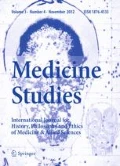Notes
Bernard (1957).
Bernard (1947).
Spiro (1985).
Kostis (2008).
Moskowitz (1983).
Oliver (1982).
Ibid.
Feinstein et al. (1994).
Ibid.
Love (1982).
Simon (2002).
Ibid.
Ibid., p. 365.
Ibid., p. 366.
Ibid.
Thompson et al. (2004).
Ibid.
Kannell and Abbott (1984).
Adlin (1998).
Medical Tribune (1992).
Ibid.
Medical World News (1988).
Cholesterol Screening in Children (1923).
Lipid Controversy Builds Up (1992).
Love (1997).
Lown (2006).
Hippocrates, Epidemics, Book I, Section 2, par.xi.
References
Adlin, V. 1998. Subclinical hypothyroidism: Deciding when to treat. American Family Physician, 776 (February).
Bernard. 1947. Principes de medicine expérimentale, Presses Universitaires de France: Paris, 391, cited in Canguilhem, Georges. 1991. The normal and the pathological (trans: Fawcett, C.). Zone Books: New York, 71.
Bernard, Claude. 1957. An Introduction to the study of experimental medicine, trans, 63–65. New York: H. C. Greene, Dover. passim.
Cholesterol Screening in Children. 1995. U. S. Public health service. American Family Physician, 1923. (June).
Feinstein, A., et al. 1994. Variability in radiologists’ interpretations of mammograms. The New England journal of medicine 331: 1493.
Kannell, W., and R. Abbott. 1984. Incidence and prognosis of unrecognized myocardial infarction. The New England journal of medicine 311: 1144.
Kostis, J. 2008. Treating hypertension in the very old. New England Journal of Medicine (NEJM) 358: 1958.
Lipid Controversy Builds Up. 1992. Medical World News, 15. (October).
Love, Susan. 1982. Fibrocystic ‘disease’ of the breast: A non-disease? The New England journal of medicine 307: 1010.
Love, Susan. 1997. Sometimes Mother Nature knows best. New York Times, 20. (March). reprinted in the Public Citizen Health Letter 13:1, 1997.
Lown, Bernard. 2006. The commodification of health care. Hastings Center Report, p. 42. (September–October).
Medical Tribune. 1992. 4 (April).
Medical World News. 1988. 51. (August).
Moskowitz, R. 1983. Vague, uncertain, long-term diagnosis: The Nocebo effect. Journal of the American Institute of Homeopathy (JAIH) 76: 26.
Oliver, M. 1982. Risks of correcting the risks of coronary disease and strokes with drugs. The New England journal of medicine 306: 297.
Simon, H. 2002. Diagnosing prostate cancer: The PSA, 364. New York: The Harvard Medical School Guide to Men’s Health, Free Press.
Spiro, H. 1985. Delayed diagnosis of disease. Journal of the AMA (JAMA) 253: 2258.
Thompson, I., et al. 2004. Prevalence of prostate cancer among men with a PSA level at or below 4.0 ng. Per Milliliter. The New England journal of medicine 350: 2239.
Author information
Authors and Affiliations
Corresponding author
Additional information
Based on an article published in the American Journal of Homeopathic Medicine 102: Spring 2009.
Rights and permissions
About this article
Cite this article
Moskowitz, R. Diagnosis. Medicine Studies 2, 121–137 (2010). https://doi.org/10.1007/s12376-010-0043-3
Received:
Accepted:
Published:
Issue Date:
DOI: https://doi.org/10.1007/s12376-010-0043-3

